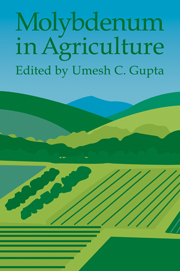Book contents
- Frontmatter
- Contents
- List of contributors
- Preface
- 1 Introduction
- 2 Chemistry and Mineralogy of Molybdenum in Soils
- 3 Distribution and Mobility of Molybdenum in the Terrestrial Environment
- 4 Biochemical Significance of Molybdenum in Crop Plants
- 5 Soil and Plant Factors Affecting Molybdenum Uptake by Plants
- 6 Analytical Techniques for Molybdenum Determination in Plants and Soils
- 7 Testing for Molybdenum Availability in Soils
- 8 Molybdenum Availability in Alkaline Soils
- 9 Deficient, Sufficient, and Toxic Concentrations of Molybdenum in Crops
- 10 Symptoms of Molybdenum Deficiency and Toxicity in Crops
- 11 Sources and Methods for Molybdenum Fertilization of Crops
- 12 Yield Responses to Molybdenum by Field and Horticultural Crops
- 13 Responses of Forage Legumes and Grasses to Molybdenum
- 14 Molybdenum and Sulfur Relationships in Plants
- 15 Molybdenum in the Tropics
- Index
8 - Molybdenum Availability in Alkaline Soils
Published online by Cambridge University Press: 10 December 2009
- Frontmatter
- Contents
- List of contributors
- Preface
- 1 Introduction
- 2 Chemistry and Mineralogy of Molybdenum in Soils
- 3 Distribution and Mobility of Molybdenum in the Terrestrial Environment
- 4 Biochemical Significance of Molybdenum in Crop Plants
- 5 Soil and Plant Factors Affecting Molybdenum Uptake by Plants
- 6 Analytical Techniques for Molybdenum Determination in Plants and Soils
- 7 Testing for Molybdenum Availability in Soils
- 8 Molybdenum Availability in Alkaline Soils
- 9 Deficient, Sufficient, and Toxic Concentrations of Molybdenum in Crops
- 10 Symptoms of Molybdenum Deficiency and Toxicity in Crops
- 11 Sources and Methods for Molybdenum Fertilization of Crops
- 12 Yield Responses to Molybdenum by Field and Horticultural Crops
- 13 Responses of Forage Legumes and Grasses to Molybdenum
- 14 Molybdenum and Sulfur Relationships in Plants
- 15 Molybdenum in the Tropics
- Index
Summary
Introduction
Molybdenum (Mo) is essential for higher plants (Arnon and Stout, 1939). As a constituent of nitrate reductase, sulfite reductase, and, in nodulated legumes, nitrogenase and xanthine oxidase, it is involved in electron-transfer reactions. Nitrate reductase, which catalyzes the conversion of nitrate to nitrite by transfer of electrons from Mo to nitrate, is an inducible enzyme that depends on Mo for its synthesis. There is a close relationship involving Mo supply, nitrate reductase activity, and plant growth. In the nitrogenase of legumes and other plants that fix atmospheric nitrogen, Mo is directly involved in the reduction of N2 (Witt and Jungk, 1977). As a constituent of xanthine oxidase it catalyzes the oxidation of xanthine to uric acid, which is a precursor of allantoin and allantoic acid in most tropical and subtropical legumes. Besides playing a catalytic role, Mo is required for plant reproductive development (Agarwala et al., 1979) and nodulation of leguminous and nonleguminous N-fixing plants (Becking, 1961).
Compared with those for other micronutrients, the physiological requirements for Mo are very low (Stout and Meagher, 1948; Hewitt, 1963). The adequate concentrations of Mo in most crops range between 0.1 and 1. Omgkg–1 (Bergmann, 1988), but the threshold for Mo toxicity in plants is much higher than that for any other micronutrient. Some plants can accumulate 1,000 times their adequate concentrations of Mo without exhibiting any visible signs of toxicity: cotton (Gossypium spp.), tomato (Lycopersicon esculentum Mill.), and Phaseolus beans (Joham, 1953; Johnson, 1966; Widdowson, 1966).
- Type
- Chapter
- Information
- Molybdenum in Agriculture , pp. 131 - 149Publisher: Cambridge University PressPrint publication year: 1997
- 1
- Cited by



